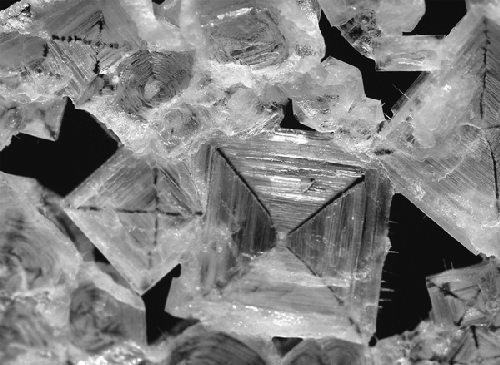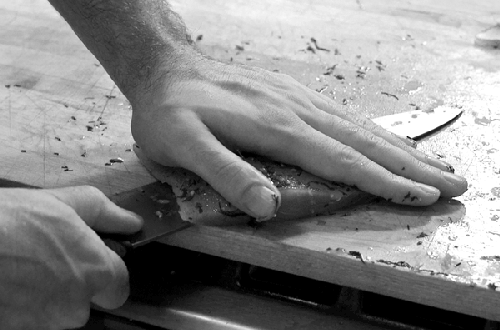Before getting into modern industrial chemicals—chemicals
that began to routinely appear in food only after World War II—let’s take a look at some
traditional food additives and the chemicals and chemistry behind them: salt (sodium
chloride), sugar (sucrose), acids and bases (citric acid, lye), and alcohol
(ethanol).1. Salt
Ahh, salt: responsible for the salvation of many a food (or is that salivation?). The
oldest seasoning in use, in small quantities it helps reduce the bitterness of foods and
enhances the other flavors in a dish . In larger quantities, it can be
used chemically to preserve food (dry and wet brining) as well as mechanically to alter
how foods cook (salt roasting).
Salt crystals.
IMAGE COURTESY OF NASA

From a chemistry perspective, salt is an ionic compound composed of a cation from a
metal or ammonium and an anion from an acid. In solid form, salt is a crystal of atoms
arranged in an alternating pattern based on charge: cation, anion, cation, anion, arranged
in a 3D checkerboard pattern.
Our tongues detect one kind of salt, sodium chloride, as being “salty.” Sodium
chloride (common table salt) is made up of sodium (a metal, and one that in its pure form
happens to react violently when dropped in water) and chloride (chlorine with an extra
electron, making it an anion). Other salts can register as different tastes. Monosodium
glutamate, for example, triggers our taste receptors for umami. In water, the salts
dissolve and the individual ions are freed, and they are then able to react and form bonds
with other atoms and molecules.
While at first glance the chemistry of salt may not seem important to everyday
cooking, it’s helpful to understand the basics of how it works when preparing and cooking
food.
Atom
Basic building block of matter; these are the elements listed in the periodic
table.
Molecule
Two or more atoms bonded together (where “or more” can be millions). H =
hydrogen atom, H2 = dihydrogen molecule.
Cation
Any positively charged atom or molecule (i.e., one that has more protons than
electrons).
Anion
Any negatively charged atom or molecule (i.e., one that has more electrons than
protons).
Note:
Cations and anions can be a single atom (Ca2+) or
anything from a small molecule (NO3) to a really large one, such
as alginate (composed of many thousands of atoms).
Applying salt to the outside of fish causes osmosis, which is the physical process
of a solvent passing through a membrane to equalize the concentration of solute on the
membrane’s other side. In animal tissue, salt (the solute) is unable to penetrate the cell walls (the
membrane) present in the tissue, so water (the solvent) leaves the cells in order to
equalize the differences in concentration. (The process of equalizing osmotic pressure
is called diffusion.) If there’s a large enough difference in
solute concentrations, at some point plasmolysis occurs—the cell structure collapses—and
if enough water leaves the cell, the cell dies. From a food safety perspective, the amount of salt necessary to cause sufficient
plasmolysis to render bacteria nonviable depends on the species of bacteria involved.
Salmonella is unable to grow in salt concentrations as low as 3% and
Clostridium botulinum dies at around 5.5%, while
Staphylococcus is hardy enough to survive in a salt concentration
up to 20%. Staphylococcus is not a common concern in fish,
according to the FDA, so food safety guidelines consider salt solutions of ~6%
sufficiently safe (except for those in an at-risk group) when curing fish. |
1.1. Dry brining
Beef jerky, salmon gravlax, sausages,
hams, prosciutto, and corned beef are all cured using salts, typically sodium chloride
(table salt) or sodium nitrate, which gives foods like salami a distinctive flavor and
pinkish color. Besides adding flavor, salt preserves these types of foods by creating an
inhospitable environment for microorganisms .
Salt curing has been used for centuries to preserve fish caught at sea, and it’s
also something that you can easily do at home. Surrounding it with a sufficient quantity
of salt draws moisture out of food; this is called dry brining. But salt doesn’t just
“dry out” the food (along with any bacteria and parasites). At sufficient concentration,
it actively disrupts a cell’s ability to function and kills it, rendering bacteria and
parasites nonviable.
Note:
This killing ability isn’t limited to just foods. For an adult human, the lethal
dose of table salt is about 80 grams—about the amount in the saltshaker on your
typical restaurant table.
Overdosing on salt is reportedly a really painful way to go, as your brain swells
up and ruptures. Plus, it’s unlikely the ER physicians will correctly diagnose the
cause in time. (Paging Dr. House.)
1.2. Wet brining
Wet brining—the process of soaking meat in salted water—can be used both to add
flavor and to reduce water loss during cooking.
As an experiment, try doing an A/B test with brined and nonbrined pork chops. Does
brining change the weight loss during cooking? Using a gram scale, weigh a pork chop
prebrining, post-brining, and after cooking, and compare the percentage weight loss to
that of a “control” pork chop that is cooked without having been brined. You may also
want to test how brining changes the flavor. If you’re cooking for others, enlist them
as tasters. Cook both brined and nonbrined pork chops, serve a portion of each to
everyone, and see what preferences your tasters have.
In a bowl, mix together:
5 teaspoons (30g) kosher salt
1 tablespoon (12g) sugar
3 tablespoons (12g) finely chopped fresh
dill
1 teaspoon (4g) vodka
1 teaspoon (2g) crushed peppercorns (ideally, use a
mortar and pestle)
On a large piece of plastic wrap, place:
1 pound (450g) salmon, washed and bones removed;
preferably a center cut so that its shape is rectangular
Sprinkle salt mixture over fish and massage into salmon. Wrap fish in plastic and
store in fridge, flipping and massaging twice a day for a day or two.
Store in the fridge and consume within a week.
Notes
Note the use of vodka as a solvent. Try substituting other spirits,
such as cognac or whiskey. And in place of dill, try using coriander seed, loose
tea leaves (e.g., Earl Grey or Lapsang Souchong), shallots, or lemon zest. The
Scandinavians traditionally serve salmon gravlax on top of bread with a mustard
dill sauce.
You can substitute other fatty fish for the salmon and obtain a
similar texture. What happens if you try tuna?
Curing inhibits most common bacterial growth but does not prevent
all types of bacteria from growing. Avoid serving this to anyone in an at-risk
group. This recipe is a bit heavy on the salt—6% by weight—to err on the side of
safety. You can reduce the saltiness by rinsing the finished product in fresh
water, followed by recoating it with dill and ground pepper to restore some of
the flavor.
Salt curing—as is done in salmon gravlax—is the first step in making
lox. After curing, lox is also cold smoked, which is the process of exposing a
food to smoke vapors that have been cooled down. You can approximate the flavor
of lox by adding liquid smoke to the rub .
You can remove the skin from a piece of fish by placing it
skin-side down on a cutting board and carefully running a knife along the
surface between the skin and flesh while using your hand to keep the fish
from sliding around.
